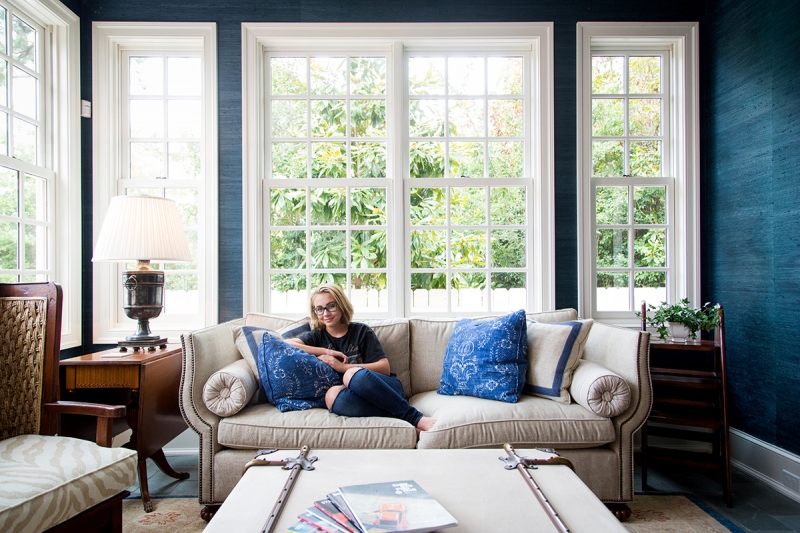High-end wall art revived a photography business
Portrait photographers Monica Sigmon and Michael Taylor of Sigmon Taylor Photography revamped their business by focusing on high-end wall art
• July 2018 issue
The combination of Monica Sigmon and Michael Taylor seemed like a match made in photography heaven. Monica Sigmon, M.Photog.Cr., had founded a successful portrait studio in Williamsburg, Virgina, in 2000 and steadily built a reputation as a popular speaker at photography events. Michael Taylor, M.Photog.Hon.M.Photog.Cr., API, F-ASP, was a past PPA president, a recognized titan of the photography industry, and a veteran speaker with more than 400 photography seminars to his credit. So when the couple merged their personal and professional lives in the mid-2000s, joining forces as Sigmon Taylor Photography in Williamsburg, they seemed destined to take the portrait photography field by storm.
And then the financial crisis hit. Sigmon and Taylor learned that a stellar reputation and a well-established business do not make you immune to a recession. By 2008, they were searching for a way to maintain revenue in rapidly changing financial times.
Going into that period, the studio had been very busy—maybe too busy. Sigmon and Taylor managed a staff of six people and were continually rushing from client to client, project to project. Their work lives were an exercise in keeping up.
As the recession deepened, clients began to drop off, and overall business volume dipped notably. To stay afloat, Sigmon and Taylor let staff size shrink through attrition until eventually it was just the two of them. “It was a struggle,” says Taylor. “Like a lot of folks, we just treaded water there for a while, and we were scrambling to find new income streams.”
“That was where we made some mistakes,” adds Sigmon. “We left our business model, which was more boutique, more high-end, and started to act more like a jack-of-all-trades. Every time the phone rang, we said yes. We did everything from mini-sessions to Santa portraits to Facebook portraits, and anything else we thought would remediate the cash flow situation. It wore us out. All we did was work. I ended up throwing out my back and had to step away from the business for six months. As I was sitting in the emergency room, I looked at Michael and said, ‘Something has to change.’ We had to get back to what we do well, something that was true to our hearts and fulfilled us creatively.”

REFOCUS
“We needed to reinvent ourselves,” says Taylor. “Or, more accurately, we had to get back to who we were. Sometimes, that can be more difficult. Doing the simple things can be hard because it’s not new, it’s not innovative, it’s not creative. But it’s going back to the basics and refocusing on what’s important that gives you the best chance to be successful. For us, that meant taking a look at the portrait side, especially our high-end portraits, and really diving into it deeper. We wanted to focus on taking care of people and spending more time with each client. And we got back to emphasizing wall portraits—reinstituting the assumption that when people come to us, they’re coming to us for a piece of wall art.”
Reemphasizing a high-end product during a time of universal belt-tightening was scary, but it was vital to the survival of the studio. Sigmon and Taylor recognized that their unique value was in providing artistic portraits. Everything else was a distraction from their real purpose—and diminished their ability to define themselves in their market. “So we cut out all the noise—the things that seemed so tempting for short-term cash flow—and we focused on doing all the things that lead to legacy portraits,” says Sigmon.
They also added value where many other professionals were scaling back services to try to recoup costs. Sigmon and Taylor offered more personal attention and took more time on each project, spending around seven to eight hours with each client from start to finish. By providing that extra value, Sigmon and Taylor elevated themselves to a level where there would be no comparison to people with more limited offerings. They wouldn’t have to compete on price and could distinguish themselves through service and artistry.
Another significant change was the development of a commercial photography line. Taylor built up a commercial division that yielded substantial revenue while also providing a bridge to the revised identity for the studio’s retail portraiture.
The result of these changes was a system that not only got Sigmon and Taylor back to their creative roots but also helped them become more efficient and more profitable. As the economy recovered, the couple found themselves doing a higher volume of work at higher profit levels than they ever managed with a full staff of six. They also positioned themselves for continued success with a leaner, meaner, more focused business model.

RECONNECT
Building or rebuilding a high-end custom portrait business isn’t as simple as announcing that you’re focusing on wall portraits. Whether times are tight or the economy is booming, you have to find the right types of clients, nurture those relationships, and build on them.
For Sigmon and Taylor, this process began with an examination of who their ideal clients are, what those clients are interested in, where those clients could be reached, and how to engage them. Once they established those parameters, Sigmon and Taylor strategically increased their community engagement to help build connections with like-minded people.
Particularly during the late 2000s, when many businesses were pulling back from charitable or community commitments, Sigmon Taylor doubled down. They increased efforts, contributions, and visibility. They put themselves in situations where they’d be top-of-mind for their target clients, supporting the same causes and showing up at the same events. They launched some of their own charitable initiatives. “People want to do business with people they like and people who are like them,” says Taylor. “So we take every opportunity we can to connect with them.”

REVITALIZE
In late 2017, coming off the best year in the studio’s history, the photographers launched Black Label by Sigmon Taylor, an upscale, personalized approach to custom portraiture. “The idea is to think of your client as if he or she is a celebrity that you are photographing for a magazine,” says Sigmon. “How different would your process be if you weren’t worried about making a sale but were just concerned with creating an iconic portrait? If you could create just one image that shows what this person is all about, what would it be?”
Sigmon spent six months building a portfolio to illustrate the style of their Black Label line. She took sales out of the equation and just shot creatively. The resulting portfolio has resonated with clients and helped launch the new brand to a lot of excitement.
Sigmon and Taylor bill these portraits as statement pieces, and they limit the sessions to 20 per year. Each appointment is longer than a typical family portrait session and includes hair and makeup, staging, more shooting time, and a completely personalized experience. Sigmon and Taylor slow down the process and help their clients feel comfortable enough to be a little vulnerable, a bit more truthful. “These portraits are meant to be bold,” says Sigmon. “They are not for the faint of heart. They are really more of a personality study, more authentic to the person. They allow us to tell a story in a way we normally wouldn’t get to tell it.”
Being able to launch a creatively inspiring portrait line like this is the result of years of building a strong brand as an upscale, specialty provider. By going back to the fundamentals and providing a high level of value year after year, Sigmon and Taylor have positioned themselves to expand into new areas that are both creatively and financially rewarding.
“It’s harder and it takes longer to do things the right way,” says Sigmon. “But the clearer your vision is and the more you stay true to yourself, the more opportunities you’ll have in the long run.”
RELATED: Lessons in rehabbing a photography business
Jeff Kent is editor-at-large of Professional Photographer.


 View Gallery
View Gallery


